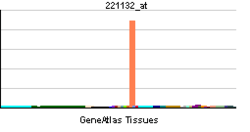CLDN18
| CLDN18 | ||||||
|---|---|---|---|---|---|---|
| Identifiers | ||||||
| Aliases | CLDN18, SFTA5, SFTPJ, claudin 18 | |||||
| External IDs | MGI: 1929209 HomoloGene: 9489 GeneCards: CLDN18 | |||||
| RNA expression pattern | ||||||
   | ||||||
| More reference expression data | ||||||
| Orthologs | ||||||
| Species | Human | Mouse | ||||
| Entrez | ||||||
| Ensembl | ||||||
| UniProt | ||||||
| RefSeq (mRNA) | ||||||
| RefSeq (protein) | ||||||
| Location (UCSC) | Chr 3: 138 – 138.03 Mb | Chr 9: 99.69 – 99.72 Mb | ||||
| PubMed search | [1] | [2] | ||||
| Wikidata | ||||||
| View/Edit Human | View/Edit Mouse |
Claudin-18 is a protein that in humans is encoded by the CLDN18 gene.[3] It belongs to the group of claudins.
CLDN18 belongs to the large claudin family of proteins, which form tight junction strands in epithelial cells .[4] [supplied by OMIM][3]
Clinical significance
Isoform 2 (Claudin 18.2) is abundant in gastric tumors.[5]
Experimental antibody IMAB362 targets Claudin 18.2 to help treat gastric cancers.[5]
References
- ↑ "Human PubMed Reference:".
- ↑ "Mouse PubMed Reference:".
- 1 2 "Entrez Gene: CLDN18 claudin 18".
- ↑ Niimi T, Nagashima K, Ward JM, et al. (2001). "claudin-18, a Novel Downstream Target Gene for the T/EBP/NKX2.1 Homeodomain Transcription Factor, Encodes Lung- and Stomach-Specific Isoforms through Alternative Splicing". Mol. Cell. Biol. 21 (21): 7380–90. doi:10.1128/MCB.21.21.7380-7390.2001. PMC 99911
 . PMID 11585919.
. PMID 11585919. - 1 2 Antibody Shines in Advanced Gastric Cancer - IMAB362 leads to longer remission, better survival. June 2016
Further reading
- Kniesel U, Wolburg H (2000). "Tight junctions of the blood–brain barrier.". Cell. Mol. Neurobiol. 20 (1): 57–76. doi:10.1023/A:1006995910836. PMID 10690502.
- Heiskala M, Peterson PA, Yang Y (2001). "The roles of claudin superfamily proteins in paracellular transport.". Traffic. 2 (2): 93–8. doi:10.1034/j.1600-0854.2001.020203.x. PMID 11247307.
- Tsukita S, Furuse M, Itoh M (2001). "Multifunctional strands in tight junctions.". Nat. Rev. Mol. Cell Biol. 2 (4): 285–93. doi:10.1038/35067088. PMID 11283726.
- Tsukita S, Furuse M (2003). "Claudin-based barrier in simple and stratified cellular sheets.". Curr. Opin. Cell Biol. 14 (5): 531–6. doi:10.1016/S0955-0674(02)00362-9. PMID 12231346.
- González-Mariscal L, Betanzos A, Nava P, Jaramillo BE (2003). "Tight junction proteins.". Prog. Biophys. Mol. Biol. 81 (1): 1–44. doi:10.1016/S0079-6107(02)00037-8. PMID 12475568.
- Strausberg RL, Feingold EA, Grouse LH, et al. (2003). "Generation and initial analysis of more than 15,000 full-length human and mouse cDNA sequences". Proc. Natl. Acad. Sci. U.S.A. 99 (26): 16899–903. doi:10.1073/pnas.242603899. PMC 139241
 . PMID 12477932.
. PMID 12477932. - Clark HF, Gurney AL, Abaya E, et al. (2003). "The Secreted Protein Discovery Initiative (SPDI), a Large-Scale Effort to Identify Novel Human Secreted and Transmembrane Proteins: A Bioinformatics Assessment". Genome Res. 13 (10): 2265–70. doi:10.1101/gr.1293003. PMC 403697
 . PMID 12975309.
. PMID 12975309. - Oh JH, Yang JO, Hahn Y, et al. (2006). "Transcriptome analysis of human gastric cancer". Mamm. Genome. 16 (12): 942–54. doi:10.1007/s00335-005-0075-2. PMID 16341674.
- Matsuda Y, Semba S, Ueda J, et al. (2007). "Gastric and intestinal claudin expression at the invasive front of gastric carcinoma". Cancer Sci. 98 (7): 1014–9. doi:10.1111/j.1349-7006.2007.00490.x. PMID 17459057.
- Liu F, Koval M, Ranganathan S, Fanayan S, Hancock WS, Lundberg EK, Beavis RC, Lane L, Duek P, McQuade L, Kelleher NL, Baker MS (2015). "A systems proteomics view of the endogenous human claudin protein family". J Proteome Res. doi:10.1021/acs.jproteome.5b00769. PMID 26680015.
This article is issued from Wikipedia - version of the 6/12/2016. The text is available under the Creative Commons Attribution/Share Alike but additional terms may apply for the media files.